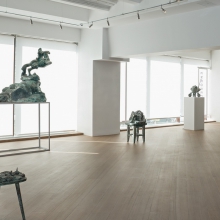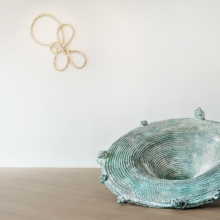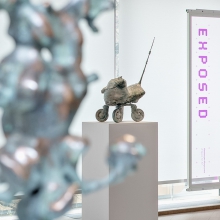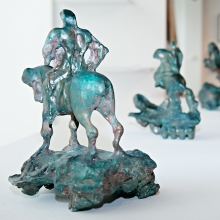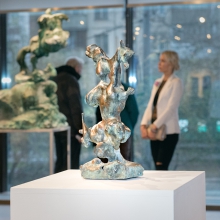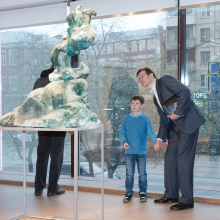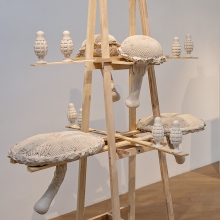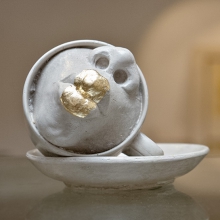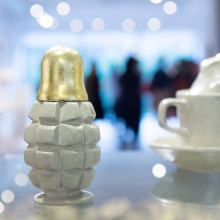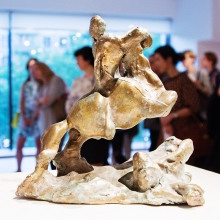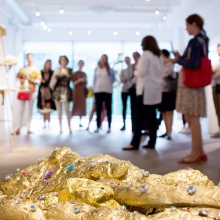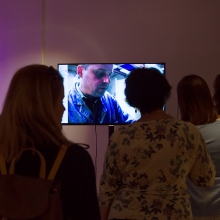THE CHASM IN THE SUNFLOWERS
“The more you feel connection to your Motherland,
the more readily you imagine it as a real living organism”
Alexander Blok
The day I was going to work on this text, I popped to the grocery store. I saw two men buying ten long loaves of bread. I have seen this sort of things several times lately. This product has still symbolical meaning in the Russian culture, and the most remarkable thing is that it designates both prosperity and hunger at once… Bread historically is a symbol of life for everybody and food for poor people.
A form of a long loaf — the simplest and tasty kind of bread — is a sort of universal symbol nowadays. It became the main model for The Breads installation (2011) by Leonid Sokhransky. It is a still life — the table is literally filled up with different bakery products: long loaves, croissants, cracknels, rolls and cakes. The ‘gypsoplasts’ of real forms are painted with gold and studded with multi-coloured sparkles. The artist synthesized two principal images of the world — money and food. These simple recognizable forms keep the secret filling. Diamond pies seem to whisper “eat me”, but we remember what happened to the Lewis Carrol fairytale heroine in this case…
Formal magnificence is deceptive. The antique myth of Midas comes to mind. Dionysus awarded him with invaluable ability to turn everything he touched into gold. The Breads by Sokhransky happened to be a prophetic meme. The similar “art object” — a long loaf cast in real gold — impressed the public more than the other treasures in the palace of the former Ukrainian President Yanukovych. So the work by Sokhransky got another interpretation.
This work is filled with a large number of hints and we can see not only an ironical relation to the madness of some current events, but also a cruel joke. This is a mirror of our daily occurrence. Even an image of gold bread, absolutely absurd in fact, unexpectedly becomes reality. Life is an oxymoron. The Oxymoron created by Sokhransky in 2008 (the top sculpture in the Tsars and Masters series) is a hommage to the two-headed eagle — the Russian state emblem of the pre- and post-socialistic time. Using the semi-abstract, floating and spreading forms the artist deprived the symbol of imperial pathos. He took away crowns from the eagles and turned them into shouting Chimeras; the scepter and the ball into something biomorphic.
There is something sad and ironic in reflecting on the well-known monuments to Peter the Great, Nicholas I and Alexander III, which decorate the central squares in St. Petersburg. These autocracy ghosts representing the past like the state emblem are just blurring shadows in the memory or water reflections changing from the slightest whiff of breeze. Sokhransky is an archeologist whose interests extend far further than searching of a new form. He pushes together great and fatal, figural and abstract things. The classical equestrian statue is transformed to a certain symbiosis of the natural forms integrating humanity and animalhood. He combines the past and the future and refers us to the real monument as the accomplished fact. The artist suggests us to dream up what these monuments could look like. What happened to them? What changed them so strongly? Leonid Sokhransky has been living mostly in Germany for about twenty years already. Therefore he has taken a contemplative position. He observes all twists and turns of the new Russia from outside, but without illusions.
In 2008 the Tsars and Masters series was originally made of multi-coloured translucent plastic and it looked very ironic like melted candles or licked lollipops. Now in 2015–2016 the artist has cast the sculptures in bronze, bringing them closer to the monumental prototypes by Falconet, Clodt and Trubetskoy. The work lost its translucent playfulness, but kept dynamics and plasticity. The movement generally is very important for him to judge by his other projects. Melted monuments or domes in soil curves… The raging substance is crystallizing in the expectation of the new Universe.
In the series devoted to Moscow (2011–2016) Sokhransky proposes a riddle again: what has happened indeed? City landscapes have changed. Monuments can be recognized — here are Red Square cathedrals and Ostankino tower — but the soil has turned into some seismically unstable substance with curves and intricate patterns looking like twisted ropes or clotted noodles. The impression is completed by the Crater object as if it were made of a thick rope, and by fantastic sunflowers with grenade-shaped matryoshki (Femme Fatale) as well.
It feels like the ground is going to crumble under your feet any minute and the crater is going to suck down the churches and the tower like a black hole. Or on the contrary, everything is just calming down and the time will spread slowly like a snail. Though Sokhransky jokingly calls his artistic style “spaghetti”, he also notes that while creating these works, he was thinking a lot about the space swirl of the Universe (“as a thread being spooled on a coil”), about the ancient Roman flamens who could predict the future by inspecting the entrails of sacrificial animals, and also about an inexhaustible subject of a labyrinth which in fact is both art and life.
Yulia Lebedeva
